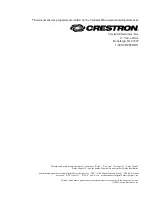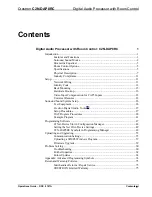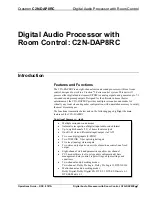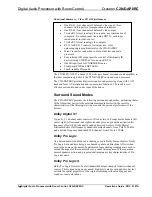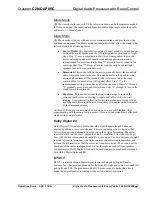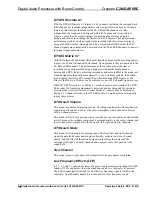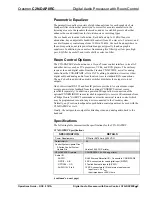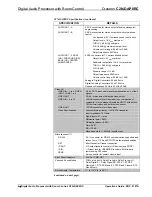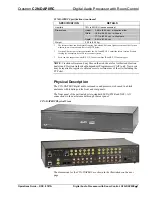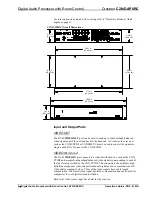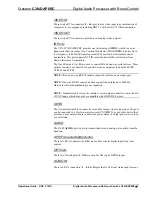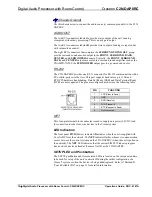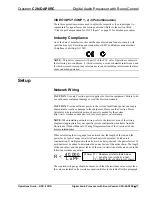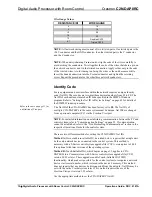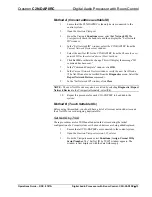
Digital Audio Processor with Room Control
Crestron
C2N-DAP8RC
4
•
Digital Audio Processor with Room Control: C2N-DAP8RC
Operations Guide - DOC. 8187A
DTS ES Discrete 6.1
With the DTS-ES Discrete 6.1 format, all 6.1 channels, including the surround back
(SB) channel, are recorded independently using a digital discrete system. The main
feature of this format is that because the SL, SR and SB channels are fully
independent, the sound can be designed with total freedom and it is possible to
achieve a sense that the acoustic images are moving about freely among the
background sounds surrounding the listener from 360 degrees. Though maximum
performance is achieved when sound tracks recorded with this system are played
using a DTS-ES decoder, when played with a conventional DTS decoder the SB
channel signals are automatically down-mixed to the SL and SR channels, so none of
the signal components are lost.
DTS ES Matrix 6.1
With this format, the additional SB channel signals undergo matrix encoding and are
input to the SL and SR channels beforehand. Upon playback, they are decoded to the
SL, SR and SB channels. The performance of the encoder used at the time of
recording can be fully matched using a high precision digital matrix decoder
developed by DTS, thereby achieving surround sound more faithful to the producer's
sound design aims than with conventional 5.1- or 6.1-channel systems. In addition,
the bit stream format is 100% compatible with conventional DTS signals, so the
effect of the Matrix 6.1 format can be achieved even with 5.1-channel signal sources.
When DTS-ES Discrete 6.1 or Matrix 6.1 encoded sources are decoded with a DTS-
ES decoder, the format is automatically detected upon decoding and the optimum
playing mode is selected. However, some Matrix 6.1 sources may be detected as
having a 5.1-channel format, so the DTS-ES Matrix 6.1 mode must be set manually
to play these sources.
DTS Neo:6 Cinema
This mode is optimum for playing movies. Decoding is performed with emphasis on
separation performance to achieve the same atmosphere with 2-channel sources as
with 6.1-channel sources.
This mode is effective for playing sources recorded in conventional surround formats
as well, because the in-phase component is assigned mainly to the center channel and
the reversed phase component to the surround (left, right, and back) channels.
DTS Neo:6 Music
This mode is suited mainly for playing music. The front (left and right) channel
signals bypass the decoder and are played directly, so there is no loss of sound
quality, and the effect of the surround signals output from the center and the
surround (left, right, and back) channels add a natural sense of expansion to the
sound field.
Two-Channel
This mode is used to play stereo source material in its pure unprocessed form.
Low Frequency Effects (LFE)
In 5.1, 6.1, and 7.1 surround formats, the point 1 represents an extra channel for LFE
sounds (120 Hz and below) that is decoded and routed to a subwoofer (if present).
The LFE channel signal is added to any other low frequency signals routed to the
subwoofer from channels unable to produce effective low frequency sound.
Содержание C2N-DAP8RC
Страница 1: ...Crestron C2N DAP8RC Digital Audio Processor With Room Control Operations Guide ...
Страница 4: ......


